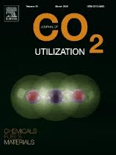
Journal of CO2 Utilization
Scope & Guideline
Leading the charge in carbon capture research.
Introduction
Aims and Scopes
- CO2 Capture and Storage Technologies:
Research on methods and technologies for capturing CO2 from various sources, including industrial emissions and direct air capture, emphasizing efficiency and cost-effectiveness. - CO2 Conversion Processes:
Innovative approaches to converting CO2 into useful chemicals and fuels, involving catalytic, electrochemical, and photochemical methods. - Material Development for CO2 Utilization:
Exploration of new materials, such as metal-organic frameworks (MOFs), zeolites, and nanocomposites, designed for enhanced CO2 adsorption, separation, and conversion. - Sustainable Practices and Life Cycle Assessment:
Studies assessing the environmental impact and sustainability of CO2 utilization technologies, including life cycle analyses to evaluate the overall benefits and trade-offs of proposed methods. - Integration of CO2 Utilization in Industrial Processes:
Research on the integration of CO2 utilization technologies into existing industrial processes, such as cement production and energy generation, to minimize carbon footprints. - Innovative Catalysts and Reaction Mechanisms:
Development of advanced catalysts and in-depth studies of reaction mechanisms that facilitate CO2 conversion, highlighting novel approaches and methodologies.
Trending and Emerging
- Electrocatalytic and Photocatalytic CO2 Reduction:
There is a growing emphasis on electrocatalytic and photocatalytic methods for reducing CO2 to hydrocarbons and alcohols, driven by advancements in materials science and nanotechnology. - Integration of CO2 Utilization with Renewable Energy:
Research increasingly focuses on integrating CO2 utilization processes with renewable energy sources, such as solar and wind, to create sustainable and circular economic systems. - Biological CO2 Utilization:
Emerging interest in biotechnological approaches for CO2 utilization, including microbial electrosynthesis and algal biofixation, highlights the potential for biological systems to convert CO2 into valuable products. - Advanced Materials for CO2 Capture:
The development of new and advanced materials, such as hybrid and multifunctional adsorbents, is gaining traction, focusing on enhancing the efficiency and selectivity of CO2 capture. - Techno-Economic and Life Cycle Assessments:
There is an increasing trend towards conducting comprehensive techno-economic and life cycle assessments of CO2 utilization technologies to evaluate their feasibility and environmental impact.
Declining or Waning
- Traditional Chemical Processes:
Interest in conventional chemical processes for CO2 utilization, such as simple thermal catalytic reactions, has diminished as researchers explore more innovative and efficient methods. - Basic Theoretical Studies:
The journal has seen a reduction in the publication of purely theoretical studies that do not offer practical applications or experimental validation, with a stronger emphasis on applied research. - Single-Use Materials:
Research focused on single-use or less sustainable materials for CO2 capture and conversion is declining as the emphasis shifts towards more sustainable, recyclable, and multifunctional materials. - Low-Temperature CO2 Conversion:
There is decreasing interest in low-temperature CO2 conversion processes, as researchers increasingly focus on high-temperature and plasma-assisted methods that offer greater efficiency and product selectivity. - Niche Applications:
Research on niche applications of CO2 utilization that lack broad industrial relevance is becoming less frequent, with a focus shifting towards scalable and economically viable solutions.
Similar Journals
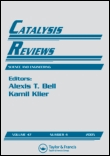
CATALYSIS REVIEWS-SCIENCE AND ENGINEERING
Navigating the Frontiers of Catalytic ScienceCATALYSIS REVIEWS - SCIENCE AND ENGINEERING, published by Taylor & Francis Inc, is a leading journal in the field of catalysis, providing a vital platform for the dissemination of rigorous research and comprehensive reviews from 1968 to the present. With an impressive Q1 ranking in multiple categories, including Catalysis and Chemistry, this journal stands out as an essential resource for professionals, researchers, and students alike. Its high impact factor and esteemed Scopus ranks — including 3rd in Chemical Engineering: Process Chemistry and Technology — highlight the journal's influence and prestige within the scientific community. While primarily a subscription-based publication, the journal’s commitment to advancing the understanding of catalytic processes continues to foster innovation in various industrial applications, making it indispensable for anyone engaged in the fields of chemical engineering and applied chemistry.

TOPICS IN CATALYSIS
Transforming Ideas into Catalytic SolutionsTOPICS IN CATALYSIS is a renowned journal published by SPRINGER/PLENUM PUBLISHERS, dedicated to advancing the field of catalysis and its applications in chemistry and chemical engineering. With its ISSN 1022-5528 and E-ISSN 1572-9028, this journal has been a critical resource since its inception in 1994, encompassing a wide range of research topics and recent advancements within the realm of catalysis, including both fundamental studies and practical applications. As of 2023, it holds a prestigious Q3 ranking in Catalysis and a Q2 ranking in miscellaneous chemistry, reflecting its impact and relevance in the academic community. With a Scopus rank of #128 in General Chemistry and #38 in Catalysis, TOPICS IN CATALYSIS is positioned to be a key contributor to the ongoing dialogue in these fields, fostering innovation and collaboration. While not an open-access journal, it provides institutional access options, ensuring that the latest findings and methodologies are available to researchers, professionals, and students worldwide. This journal is essential for those looking to stay at the forefront of catalysis research and its transformative potential in science and industry.
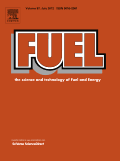
Fuel
Charting New Frontiers in Fuel TechnologyFuel is a premier international journal published by Elsevier Science Ltd, showcasing critical advancements and insights in the fields of chemical engineering, energy engineering, power technology, and organic chemistry. With a significant history dating back to 1922 and continuous publication from 1970 to 2025, Fuel holds an impressive position in the academic community, reflected in its top-tier rankings—Q1 in multiple categories including Fuel Technology and Chemical Engineering for the year 2023. This journal is dedicated to exploring innovative research and application of fuel technologies, driving forward the dialogue on sustainable energy solutions. Researchers and professionals alike will find Fuel to be an essential resource, providing access to high-impact articles that contribute to advancements in methodologies and applications, while navigating the complexities of global energy challenges.

Green Energy & Environment
Exploring the Frontiers of Green Energy and Ecological Sustainability.Green Energy & Environment, published by KEAI PUBLISHING LTD, stands as a pioneering journal dedicated to the dynamic fields of renewable energy, sustainability, and environmental science. With its ISSN 2096-2797 and E-ISSN 2468-0257, this Q1 journal holds a noteworthy presence in academic discourse, reflecting its high-quality contributions within these critical areas of research. Launched in 2016, it has consistently embraced an Open Access model, facilitating unhindered access to research findings and fostering collaboration across global communities. Based in Beijing, China, this journal is dedicated to disseminating innovative insights that are essential for addressing urgent global challenges related to energy and environmental sustainability. Researchers, professionals, and students alike benefit from a platform that not only showcases pioneering research but also encourages interdisciplinary dialogue and knowledge exchange in the pursuit of a sustainable future.

TRANSACTIONS OF TIANJIN UNIVERSITY
Bridging disciplines to illuminate the path of scientific discovery.TRANSACTIONS OF TIANJIN UNIVERSITY, published by SpringerNature, is a premier journal in the field of multidisciplinary research, boasting an impressive Q1 ranking and placing within the top 93rd percentile of its category according to Scopus. With an ISSN of 1006-4982 and E-ISSN of 1995-8196, this journal facilitates insightful and innovative contributions that span various disciplines, making it a vital resource for academics and professionals alike. Established in 2004, the journal continues to thrive with a commitment to advancing knowledge and fostering collaboration in scientific inquiry. TRANSACTIONS OF TIANJIN UNIVERSITY aligns with global research trends and offers a platform for the dissemination of high-quality research findings, promoting interdisciplinary approaches to solving complex problems. Located in China, its influence extends well beyond national borders, appealing to a diverse readership eager to explore the latest advancements and discussions in the multidisciplinary arena.
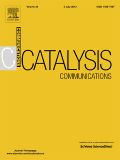
CATALYSIS COMMUNICATIONS
Advancing the Frontiers of Catalysis ResearchCATALYSIS COMMUNICATIONS is a prestigious journal published by Elsevier, focusing on advancements in the field of catalysis, an essential component of chemical engineering and process technology. With an ISSN of 1566-7367 and an E-ISSN of 1873-3905, this journal is dedicated to the rapid publication of original research and innovative findings that drive progress in catalysis. Recognized for its quality, CATALYSIS COMMUNICATIONS holds a Q2 ranking within the categories of Catalysis, Chemistry (miscellaneous), and Process Chemistry and Technology as of 2023, positioning itself in the upper tier of scholarly publications in its field. The journal has made significant contributions to the scientific community since its inception in 2000, with ongoing research until 2024. While it currently operates without an open-access option, the platform ensures rigorous peer review, maintaining high standards for publication. By engaging with the latest research, CATALYSIS COMMUNICATIONS serves as a vital resource for researchers, professionals, and students, fostering innovation and collaboration in chemical sciences.
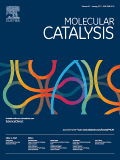
Molecular Catalysis
Pioneering Research in Catalytic ProcessesMolecular Catalysis, published by Elsevier in Netherlands, is a premier academic journal that explores the cutting-edge domain of catalytic science. With an impressive impact factor and classified in the top quartiles (Q2) in various fields such as Catalysis, Physical and Theoretical Chemistry, and Process Chemistry and Technology, this journal stands as a significant resource for researchers and professionals committed to advancing the understanding of catalysis processes. Since its inception in 2017, it has been pivotal in publishing high-quality, peer-reviewed research that addresses crucial challenges and innovations in molecular catalysis. The journal is fully Open Access, allowing unrestricted access to its articles, thus fostering a wider dissemination of knowledge. Recognized for its rigorous editorial standards, it features works that push the boundaries of current scientific understanding, making it an essential platform for students and academics alike to share and grow in their expertise.
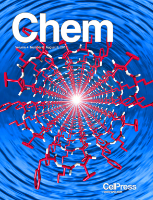
Chem
Exploring the Depths of Biochemistry and BeyondChem, published by CELL PRESS, is a renowned academic journal that has rapidly established itself as a leading platform for cutting-edge research in diverse areas such as biochemistry, chemical engineering, materials chemistry, and environmental chemistry. Released under the ISSN 2451-9294, this esteemed journal has achieved an impressive Q1 category ranking across multiple disciplines in 2023, highlighting its significant impact and prominence within the academic community. With a strong focus on innovative studies and interdisciplinary approaches, Chem fosters a vibrant dialogue among researchers, professionals, and students, making it an indispensable resource for those seeking to advance their knowledge and contribute to the evolving field of chemistry. As an open access journal, it aims to democratize knowledge, ensuring that critical research is accessible to a global audience. With its headquarters based in Cambridge, MA, it continues to lead the charge in the dissemination of pivotal findings that shape our understanding of chemical sciences.

Bulletin of Chemical Reaction Engineering and Catalysis
Showcasing Transformative Insights in Chemical Reaction EngineeringBulletin of Chemical Reaction Engineering and Catalysis is a distinguished open-access journal published by UNIV DIPONEGORO, focusing on pivotal advancements in the fields of chemical reaction engineering and catalysis. Since its inception in 2008, this journal has served as a vital platform for disseminating cutting-edge research, catering to a diverse readership that includes researchers, professionals, and students in chemical engineering and related disciplines. With its dedication to publishing valuable insights, the journal has been indexed in Scopus and boasts respectable rankings across various categories, including Q3 in Chemical Engineering (miscellaneous) and Q4 in Catalysis as of 2023. It continues to foster scholarly dialogue and collaboration by providing an accessible means for contributors to share their findings. Operating from Semarang, Indonesia, this journal underscores its commitment to advancing knowledge in chemical sciences, making it an essential resource for those engaged in the study and application of chemical processes.

ADSORPTION-JOURNAL OF THE INTERNATIONAL ADSORPTION SOCIETY
Pioneering Knowledge in Surfaces and InterfacesADSORPTION: Journal of the International Adsorption Society is a premier peer-reviewed journal, published by Springer, dedicated to advancing the understanding of adsorption phenomena across a wide range of applications in chemical engineering, chemistry, and surfaces and interfaces. With an impressive impact factor and renowned rankings—being positioned in the top quartile for Chemical Engineering and high percentiles in Chemistry and Physics—this journal serves as a vital resource for researchers, professionals, and students aiming to keep abreast of cutting-edge developments from 1995 through 2024 and beyond. The journal is pivotal in facilitating the dissemination of knowledge, fostering interdisciplinary collaboration, and showcasing innovative research in adsorption science. Although it does not operate under an open access model, its importance within the academic community is undeniable, providing significant insights into both theoretical and practical aspects of adsorption processes.